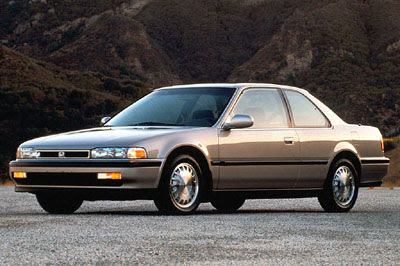The 4th Generation Honda Accord was launched in Japan in 1990 as a based on the "CB" chassis Accord. The 4th Generation Honda Accord was the first not to feature a three-door model, and the first one to be exclusively sold by the Honda Clio dealer network in Japan. A sister car, called the Honda Ascot, differing only slightly from the JDM Accord sedan, was launched for sale in Honda Primo stores that also carried previous-generation Accords. On the other hand, the Honda Vigor, previously closely related to the Accord, became a rather different model, fitted with a longitudinally-mounted inline five-cylinder engine.
 |
| Honda Accord Sedan 1990 |
The 4th Generation Honda Accord was one of the first U.S. production cars to feature optic reflectors with completely clear lenses on the headlamps replacing the more conventional lens diffused lighting. Unlike most manufacturers moving away from traditional sealed beam lighting, Honda chose to transition to a multi-reflector headlight style while maintaining the use of a glass lens instead of plastic.
For this 4th generation Accord, Honda made significant engineering design improvements. All Accords sold in North America came with a completely new all aluminium 2.2 liter 16-valve electronic fuel injected engine standard, replacing the previous 2.0 liter 12-valve model from the past generation. Also noteworthy, all Accords equipped with automatic transmissions used an electronically controlled rear engine mount to reduce low frequency noise and vibration. The mount contained 2 fluid filled chambers separated by a computer controlled valve. At low engine speeds, fluid is routed through the valve damping vibration. Above 850 rpm, fluid is routed around the valve making the engine mount stiffer.
 |
| Honda Accord 1991 |
 |
| Honda Accord 1992 |
Some new dealer-installed accessories were now offered including a single-disc in-dash CD player or trunk mounted 6-disc CD changer, stereo equalizer, fog lights, security system, rear wing spoiler, trunk lip spoiler, luggage rack, full and half nose mask, center armrest, window visors, sunroof visor, car cover, and a cockpit cover.
 |
| Honda Accord 1993 |
In 1991 Honda unveiled the Accord Wagon, manufactured at the Marysville, Ohio plant. The Ohio plant exported right-hand drive wagons and coupes to Europe and Japan. European and Japanese vehicles had options not available within the U.S. including automatic climate control systems, power seats and several other minor features. The Accord Wagons were available only in LX and EX trim in North America or just 2.2i in Japan. They had larger front brakes to compensate for the added weight and unlike other U.S. Accords, included a driver's side airbag as standard equipment. Other than a retractable tonneau cover in the rear cargo area and keyless entry on EX models, the wagons were equipped the same as their coupe and sedan counterparts.
Related Posts:


